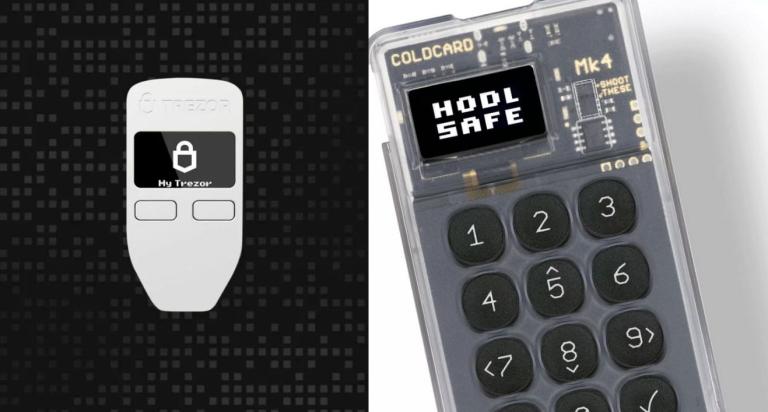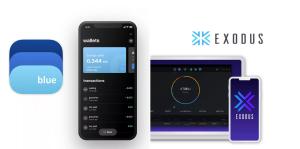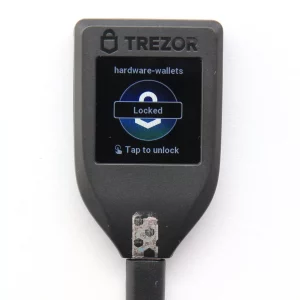If you’re deciding between Coldcard and Trezor wallets, it’s essential to compare their key features, ease of use, and transaction security. Both provide robust security, but let’s explore which one might be the best fit for you.
What is Trezor Wallet?
Launched in 2013 in the Czech Republic, Trezor wallet is the first Bitcoin hardware wallet and is widely respected hardware wallet that provides a secure way to store Bitcoin and other cryptocurrencies. It was developed by SatoshiLabs, a company founded by Marek Palatinus and Pavol Rusnak, and has grown to be a popular choice for users seeking a well-established open source hardware wallet and reliable solution.
Trezor supports multiple cryptocurrencies, making it unappealing for users who want to focus on Bitcoin. Additionally, it integrates with popular wallets like Electrum, Wasabi, and Exodus, and offers features such as a built-in exchange and privacy tools like Tor.
What is Coldcard?
Coldcard, launched in 2017 in Canada, is a hardware wallet designed specifically for Bitcoin maximalists. It operates as an air-gapped wallet, keeping your private keys completely isolated from the internet. This greatly reduces the risk of theft by preventing remote hacking attempts.
Coldcard allows transactions to be signed offline using SD cards or by connecting to a computer via USB, but the air-gapped mode ensures a high level of security for sensitive data. Coldcard’s design focuses exclusively on Bitcoin, making it a great choice for users who want a Bitcoin-only experience.
Use promo code CKBTC to get 5% off your Coldcard purchase when you pay in Bitcoin
Ease of Use
Trezor offers a more user-friendly experience, particularly for beginners. Its desktop app, Trezor Suite, is available in multiple languages (English, Spanish, Russian, Japanese, and Czech) and provides a simple interface for managing assets. However, setting up Trezor requires a computer connection, which could be a barrier for users seeking a standalone wallet.
Coldcard, with its keypad-based command interface, has a steeper learning curve. It’s ideal for advanced users who prioritize security and don’t mind sacrificing ease of use for the added protection of air-gapped transactions.
Price Comparison
One major difference between Coldcard and Trezor is the price. Coldcard is priced at $157.94, offering advanced security features tailored specifically for Bitcoin. Trezor, on the other hand, provides several models with varying price points:
- Trezor Model One: $59 (affordable, but lacks some advanced features)
- Trezor Safe 3: $79 (newer model with moderate features)
- Trezor Model T: $179 (premium model with a touchscreen, microSD slot, and built-in exchange)
The Trezor Model T is designed for users who want more advanced features and a broader selection of cryptocurrencies. However, for Bitcoin maximalists, Coldcard’s Bitcoin-only focus may be a better fit despite the higher price.
Security
Both Coldcard and Trezor provide excellent security features, including PIN protection and recovery phrases. However, there are some distinctions in their approach.
Coldcard offers features like duress wallets and air-gapped transaction signing, making it highly secure against theft and hacking attempts. It also mitigates “Klepto” attacks by requiring a PIN and using advanced entropy generation for strong private keys. However, Coldcard is not open source, meaning its code is not publicly available for review and verification, which may be a concern for those who prioritize transparency in their hardware wallet’s design.
Trezor, on the other hand, is fully open source. This means that its code can be audited by anyone, providing greater transparency and trust in how the wallet operates. While Trezor also employs a PIN and recovery seed, it stores private keys directly on the device, making it more vulnerable to physical attacks if the wallet is stolen. Trezor does not use blind oracle signing, which could be a downside for users prioritizing privacy and security.
Both wallets use a combination of human interaction and internal randomness for entropy generation, ensuring secure key creation. Coldcard’s stateless signing offers an additional layer of security since private keys are not stored on the device itself.
Key Features
When evaluating hardware wallets, the Trezor and Coldcard present distinct options. Trezor supports multiple cryptocurrencies, including Bitcoin. Unlike Coldcard, which focuses exclusively on Bitcoin, Trezor also integrates a built-in exchange for buying and selling Bitcoin. It offers privacy features such as Tor for enhanced anonymity, which are not available on Coldcard.
While Trezor supports a range of address types including SegWit, Taproot, and Legacy, Coldcard supports SegWit for efficient transactions. The user interface on Trezor includes button-based navigation with an optional touchscreen on the Model T, providing a more interactive experience compared to Coldcard, which relies on physical buttons only.
In terms of integrations, both connects with wallets like Electrum, Wasabi, BlueWallet, and Exodus. It’s worthy noting that Coldcard emphasizes security features such as air-gapped signing for offline transactions and multisig support to enhance protection against potential threats. However, you can use multisignature transactions with your Trezor device and Electrum, not on Trezor Suite.
Coldcard distinguishes itself with its use of stateless signing for added security and BIP39 seed phrases for wallet recovery, features that are not offered by Trezor. Additionally, Coldcard includes two-factor authentication (2FA) for additional account security, a feature not present in Trezor’s design. On the security front, Trezor’s Model T includes a MicroSD card slot for physical attack protection, a unique feature not found in Coldcard.
Trezor vs Coldcard: Summary
For a quick comparison of Trezor and Coldcard, take a look at the table below:
| Feature | Trezor | Coldcard |
|---|---|---|
| Launch Year | 2013 | 2017 |
| Location | Czech Republic | Canada |
| Focus | Multi-currency (includes Bitcoin) | Bitcoin-only |
| Open Source | Yes | No |
| Security | PIN, recovery seed; private keys stored on device, open source | Air-gapped signing, duress wallets, stateless signing |
| Ease of Use | User-friendly, Trezor Suite app in multiple languages (English, Spanish, Russian, Japanese, and Czech) | Steeper learning curve, keypad-based interface |
| Price | Trezor Model One: $59 Trezor Safe 3: $79 Trezor Model T: $179 | $157.94 |
| Key Features | Built-in exchange, privacy tools (Tor), supports multiple address types (SegWit, Taproot, Legacy) | Air-gapped transactions, multisig support, stateless signing, 2FA, supports SegWit |
| Integration | Electrum, Wasabi, Exodus, BlueWallet | Electrum, Wasabi, BlueWallet |
| Advanced Security | MicroSD card slot (Model T), BIP39 seed phrases | High focus on offline security, BIP39 seed phrases |
| Use Case | Supports Bitcoin and various cryptocurrencies (altcoins/shitcoins), extensive integrations | Ideal for Bitcoin-only users prioritizing high security |
Use promo code CKBTC to get 5% off your Coldcard purchase when you pay in Bitcoin
Coldcard vs Trezor: Is Coldcard Better Than Trezor?
When deciding between Coldcard and Trezor, it largely depends on your priorities and use case. Coldcard is designed with Bitcoin maximalists in mind, offering features tailored specifically to those who are solely interested in storing and transacting with Bitcoin. It offers advanced features like air-gapped transactions, duress wallets, stateless signing, and strong multisig support. These features make Coldcard ideal for users who prioritize security above all and want to eliminate any distractions from altcoins. For those focused on Bitcoin-only holdings, Coldcard’s dedicated approach offers a compelling choice.
However, Coldcard is not open source, which may raise concerns for users who prioritize transparency and the ability to audit their device’s code. Trezor, on the other hand, is fully open source, ensuring public access to its design and operation for security audits. Trezor supports multiple cryptocurrencies. However, this can be distracting, especially for beginners. New users may find themselves overwhelmed by the wide array of altcoins available on Trezor, potentially leading to confusion or missteps in managing their portfolio. For Bitcoin-only users, this multi-currency support might feel unnecessary, adding complexity to what could otherwise be a streamlined experience focused purely on Bitcoin.
Additionally, Trezor is known for its ease of use, offering a user-friendly experience through its Trezor Suite app, available in multiple languages. Coldcard, in contrast, has a steeper learning curve due to its keypad-based interface and more technical operations, though this might be a small price to pay for the enhanced security features.
When it comes to pricing, Trezor offers a broader range, with the entry-level Model One priced at $59, while Coldcard is priced at $157.94. Trezor also provides privacy tools like Tor and supports various address types (SegWit, Taproot, Legacy), while Coldcard is laser-focused on Bitcoin transactions, ensuring strong offline security measures, such as air-gapped transactions.
In summary, Coldcard is a great choice for Bitcoin maximalists who demand top-tier security and wish to avoid distractions from altcoins, while Trezor offers an open-source hardware wallet with a user-friendly interface.



























